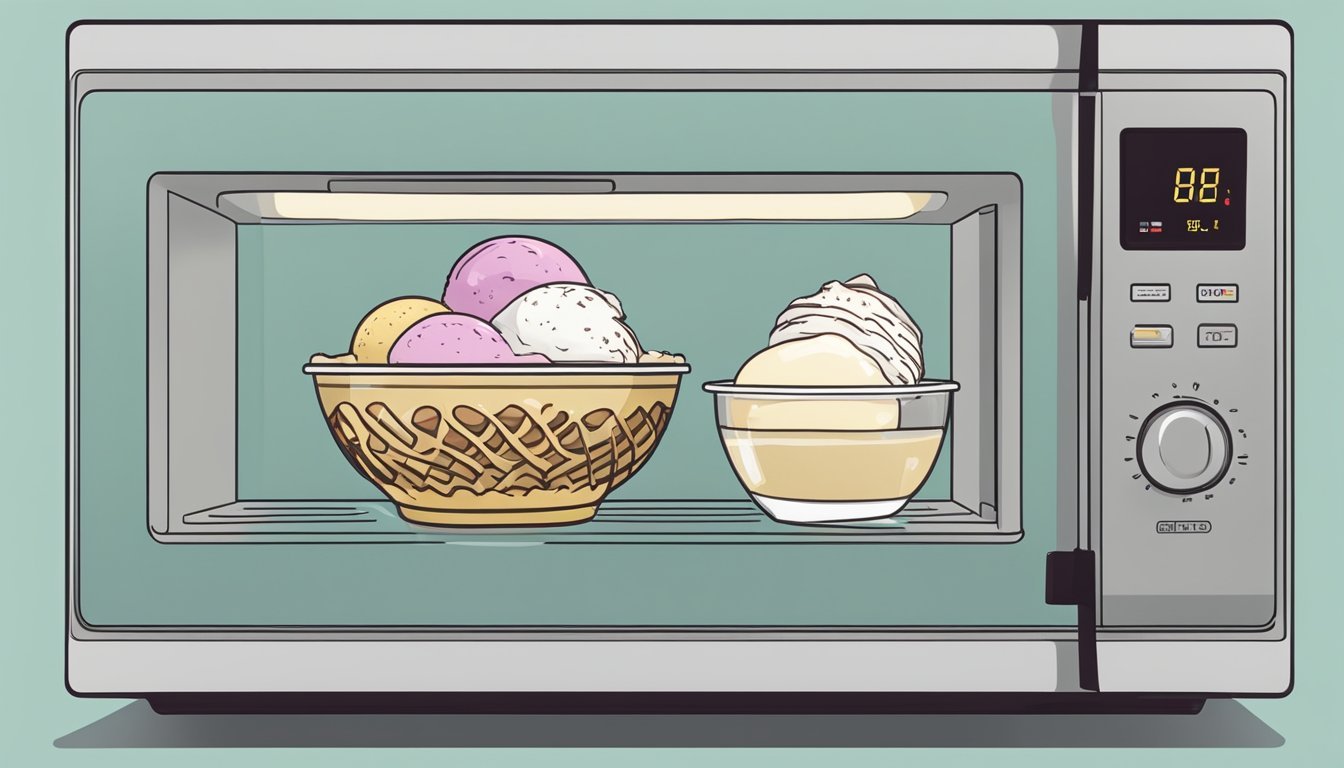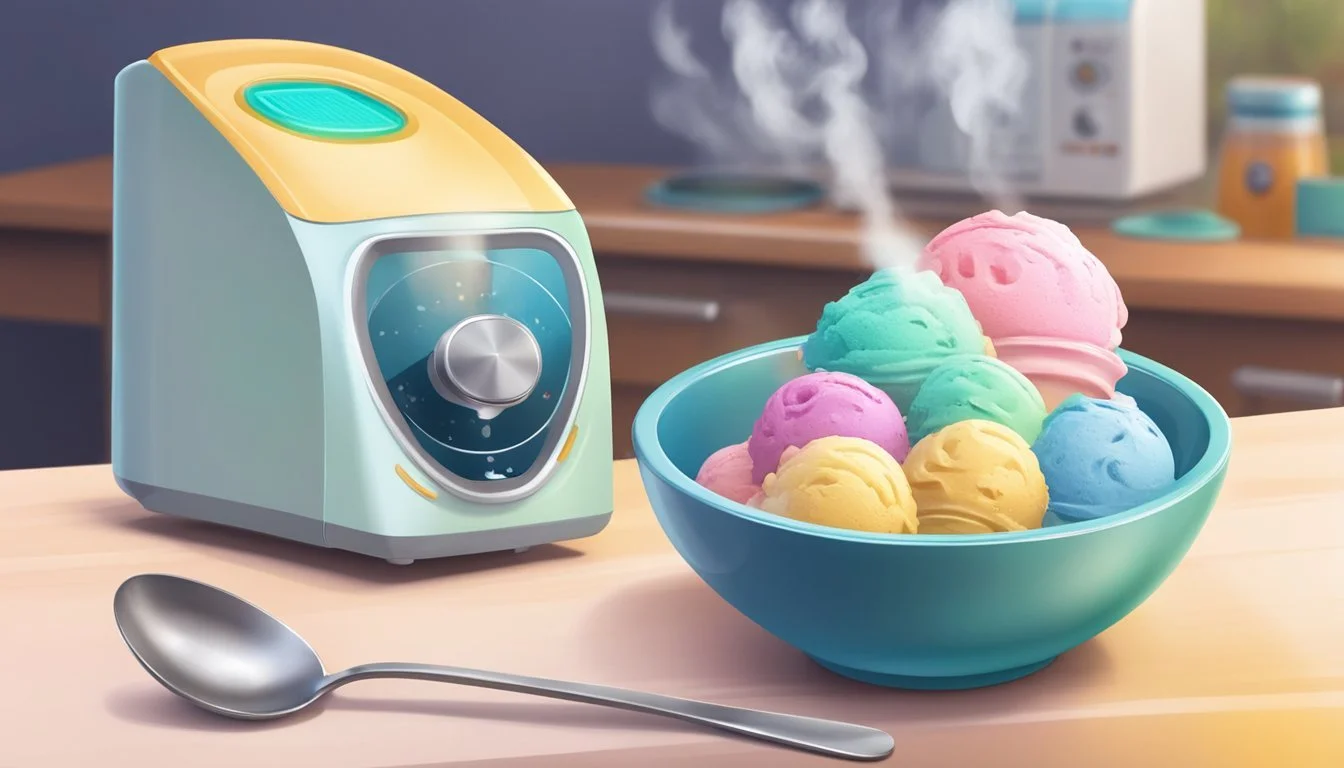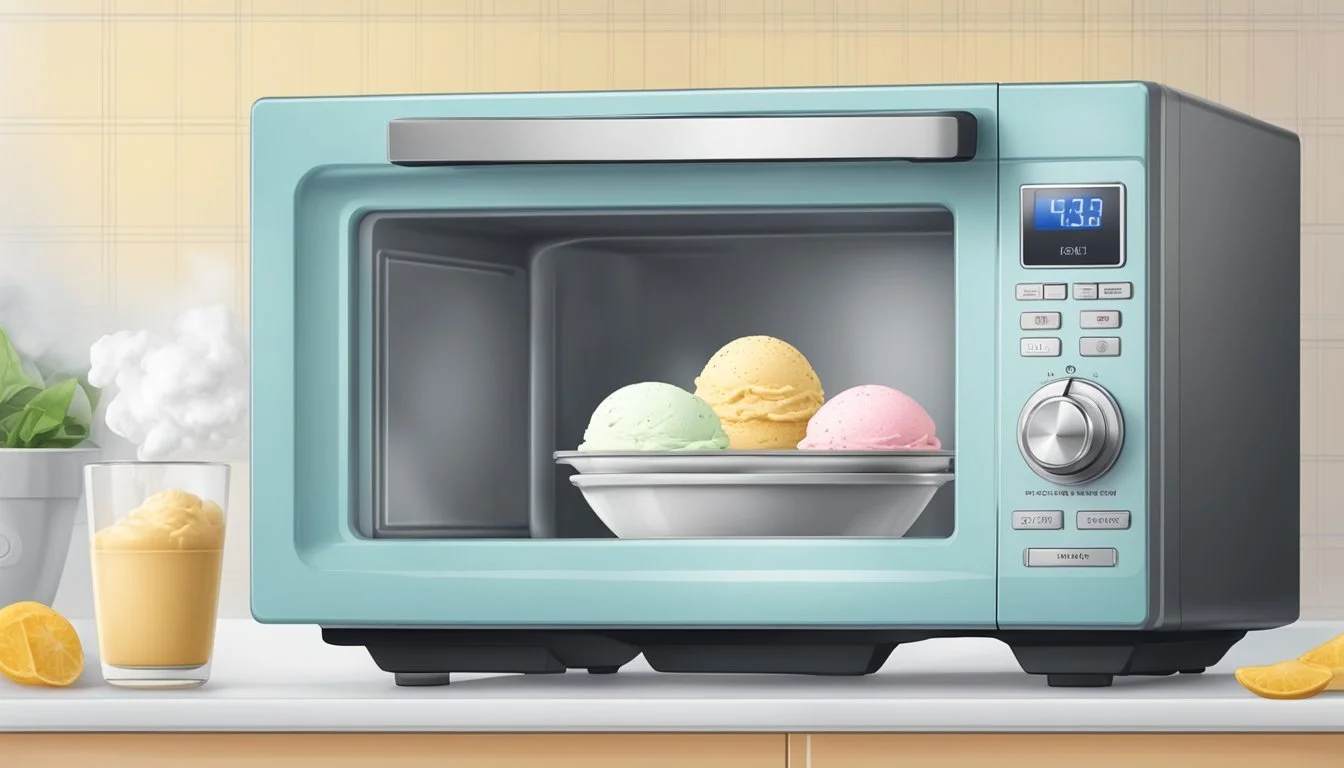How to Reheat Gluten-Free Ice Cream
Best Tips and Methods
Reheating gluten-free ice cream might sound unusual, but it's a handy technique to soften it for easier scooping and serving. Often, gluten-free ice cream can become harder and more challenging to handle compared to its conventional counterparts due to the absence of certain stabilizers. To reheat gluten-free ice cream, place it in the microwave for 5-10 seconds or let it sit at room temperature for a few minutes.
Many people enjoy gluten-free ice cream for its natural ingredients and the ease of avoiding gluten contamination. This frozen delight can sometimes freeze harder, making instant enjoyment a bit tricky. By following simple reheating methods, you can achieve the perfect consistency without compromising the quality or flavor.
Once the ice cream reaches the desired softness, you can scoop it out effortlessly and enjoy it or mix in other gluten-free ingredients like brownies or cookie dough bits. This approach ensures that every bite is a pleasure, maintaining the creamy texture and flavor that makes gluten-free ice cream special.
Understanding Gluten-Free Ice Cream
Gluten-free ice cream caters to individuals with gluten intolerance or celiac disease and comes in various forms, including dairy and non-dairy options. Several brands have certified gluten-free products, ensuring safety for those with gluten sensitivity.
Defining Gluten-Free
"Gluten-free" signifies that a product does not contain gluten, a protein found in wheat, barley, and rye. Gluten-free ice cream is crucial for people with celiac disease, an autoimmune disorder where gluten ingestion damages the small intestine. Even trace amounts of gluten can trigger problems, making it essential to verify the gluten-free status of all ingredients.
Types of Gluten-Free Ice Cream
Gluten-free ice cream includes both traditional dairy-based and non-dairy alternatives.
Dairy-Based: These are made from milk and cream but exclude any gluten-containing additives. Notable brands include Haagen-Dazs and Breyers Ice Cream.
Non-Dairy Alternatives: These cater to those avoiding both gluten and dairy. Options use bases like almond, soy, or coconut milk. Brands such as Halo Top and Talenti offer several non-dairy, gluten-free flavors.
Choosing the right type depends on dietary needs and preferences.
Certified Gluten-Free Brands
Several brands ensure their products are certified gluten-free by reputable organizations. This certification involves rigorous testing to prevent cross-contact with gluten.
Ben & Jerry's: Known for a range of certified gluten-free flavors, including both dairy and non-dairy options.
Haagen-Dazs and Breyers Ice Cream: Offer multiple flavors that meet gluten-free criteria.
Halo Top: Provides various low-calorie, gluten-free, and dairy-free choices.
These certifications give consumers confidence in the safety and gluten-free status of their favorite ice creams.
The Importance of Safe Reheating
Safe reheating of gluten-free ice cream is vital for health, flavor, and avoiding cross-contact with gluten. Proper techniques help preserve texture and taste while ensuring the ice cream remains safe for consumption.
Minimizing Health Risks
Incorrect reheating can introduce health risks. Reheating at the right temperature kills any potential bacteria. For gluten-free ice cream, this process prevents the growth of harmful microorganisms that could affect those with celiac disease or gluten sensitivities.
Moreover, using clean utensils and surfaces is essential. Contaminated tools can introduce gluten or other allergens. This step is critical to maintaining the integrity of gluten-free products and ensuring the safety of consuming ice cream that has been thawed and refrozen.
Maintaining Quality and Flavor
The quality and flavor of gluten-free ice cream can be compromised during reheating if not done correctly. Gentle reheating methods, such as letting the ice cream soften slightly at room temperature, help maintain its creamy texture and rich taste.
Reheated too quickly or unevenly, ice cream can develop an unpleasant texture. Controlled reheating methods, such as a low-temperature oven or microwave settings designed for defrosting, ensure the ice cream remains smooth and enjoyable. The flavors, whether they are chocolate peanut butter swirl or coconut almond fudge chip, should stay intact.
Preventing Cross-Contact
Preventing cross-contact with gluten is paramount when reheating gluten-free ice cream. Cross-contact can occur through utensils, containers, or serving areas that have been in contact with gluten. This is especially risky for those with severe gluten allergies or celiac disease.
To avoid this, use dedicated gluten-free utensils and clearly label containers. Storing reheated ice cream in separate, well-marked containers helps manage cross-contact risks. Additionally, educating everyone involved in the reheating process about the importance of these practices ensures that the integrity of the gluten-free ice cream is preserved.
Preparation for Reheating
Proper preparation for reheating gluten-free ice cream ensures minimal texture loss and maintains flavor integrity.
Selecting the Right Utensils
Using the correct utensils is vital when reheating gluten-free ice cream. Opt for non-stick saucepans or heavy-bottomed pans to evenly distribute heat. Silicone spatulas are ideal for stirring as they prevent scratching the pan's surface and reduce the risk of contamination. Additionally, a thermometer helps monitor and maintain the correct temperature, preventing the ice cream from melting too much or refreezing incorrectly.
Avoid using utensils made of materials that might react with the ingredients, like certain metals. Ensuring all utensils are dry before use is equally important to prevent dilution of the ice cream.
Pre-Reheat Thawing Methods
Thawing is a crucial step before reheating gluten-free ice cream. One of the most effective methods is refrigeration thawing, where the ice cream is moved from the freezer to the refrigerator for a few hours. This method helps maintain a constant, low temperature, preventing ice crystals from forming.
Alternatively, countertop thawing can be employed for quicker results. Leave the ice cream out for 10-15 minutes at room temperature. However, keep in mind that this method requires close monitoring to avoid over-thawing.
Using these methods helps retain the ice cream’s creamy texture and rich flavor while making it easier to manage during the reheating process.
Reheating Techniques
Reheating gluten-free ice cream requires a gentle approach to maintain its unique texture and flavor. These methods ensure you can enjoy your ice cream without compromising its quality.
Microwave Method
To reheat gluten-free ice cream using a microwave, place it in a microwave-safe bowl. Set the microwave to low power to avoid melting the ice cream too quickly.
Begin by heating it for 10-15 seconds. If needed, continue reheating in 5-second intervals.
Stir the ice cream gently between intervals to promote even heating. Be cautious as microwaving for too long can cause the ice cream to melt unevenly and lose its creamy consistency.
Stovetop Method
For a stovetop reheat, use a small saucepan. Place the ice cream in the pan and set the stove to the lowest heat setting.
Heat the ice cream slowly, stirring continuously. This prevents it from sticking to the pan and ensures it melts evenly. If the ice cream starts melting too quickly, remove it from the heat and continue stirring off the burner.
This method allows for greater control over the melting process.
Oven Method
The oven method is less common but can be effective for larger quantities. Preheat the oven to 200°F (93°C). Place the ice cream in an oven-safe dish and cover it with aluminum foil.
Heat for about 5-10 minutes. Check frequently to ensure it does not overheat. Stirring occasionally helps maintain an even temperature throughout.
This method is ideal for achieving a consistent texture without the risk of overheating spots.
Serving and Presentation
Reheating gluten-free ice cream properly not only ensures optimal taste but also enhances its presentation. Here’s how to serve it at the right temperature and present it creatively for a delightful dessert experience.
Proper Serving Temperatures
To serve gluten-free ice cream at its best, bring it to a slightly softened state after reheating.
Softening Time: Typically, allow the ice cream to sit at room temperature for 5-10 minutes. This ensures a creamy texture while maintaining its shape.
Ideal Temperature: The ideal serving temperature is around 6-10°F (-14 to -12°C). This balance prevents it from being too hard or too melted.
Creative Presentation Ideas
Elevate the appeal of gluten-free ice cream with these imaginative serving ideas:
Sundaes: Use gluten-free toppings like dairy-free chocolate syrup, fruit, and nuts. Layer them in tall glasses for a visually appealing sundae.
Banana Split: Slice a banana lengthwise and place scoops of ice cream between the halves. Garnish with gluten-free chocolate chips, whipped cream, and cherries.
Ice Cream Sandwiches: Use gluten-free cookies or brownie pieces. Make small sandwiches and freeze them briefly before serving to keep them intact.
Fancy Bowls: Present single scoops in small, elegant bowls with a mint leaf on top. Add a drizzle of honey or agave for extra flavor.
Popular Gluten-Free Ice Cream Flavors and Additions
This section covers classic flavors, seasonal and specialty flavors, and innovative mix-ins and toppings that make gluten-free ice cream a treat. Each subtopic provides specific examples that cater to a variety of tastes.
Classic Flavors
Chocolate, Strawberry, and Vanilla are staple flavors in the gluten-free ice cream world.
Brands like Haagen-Dazs and Breyers provide these iconic tastes. These flavors are often found in natural vanilla or strawberry forms without artificial additives. Chocolate ice cream frequently includes rich cocoa and high-quality ingredients to enhance flavor.
Vanilla Bean and Mint Chip are also popular choices. They offer a balance of smoothness and refreshing mint. Additionally, Butter Pecan and Chocolate Peanut Butter provide both creamy textures and nutty, savory notes, making them a hit among ice cream enthusiasts.
Seasonal and Specialty Flavors
Seasonal flavors bring unique variations to gluten-free ice cream.
Pumpkin Pie and Cinnamon make their appearance during fall, offering warm, nostalgic tastes. For a summer twist, options like Mango and Lemon Sorbet provide a refreshing tang, perfect for hot days. Green Tea Ice Cream caters to those seeking a more exotic flavor, blending creamy texture with the subtle bitterness of matcha.
Other specialty offerings include Sea Salt Caramel and Coffee Ice Cream. The sweet and salty contrast of sea salt caramel is a unique treat, while coffee ice cream provides a robust flavor that appeals to coffee lovers.
Innovative Mix-ins and Toppings
Innovative additions can elevate the gluten-free ice cream experience.
Popular mix-ins such as Cookie Dough and Salted Caramel add texture and complexity to basic flavors. Honey and Peanut Butter offer a rich, sweet, and slightly savory taste. Pistachio and Blueberry mix-ins provide both nuttiness and fruity freshness, respectively.
Toppings like Strawberries, Bananas, and Caramel drizzle enhance the flavor profile. Sea Salt and Chocolate Chips can dramatically amplify the overall taste, making each bite more delightful. Simple additions like Blueberries can provide an additional layer of flavor, transforming a regular ice cream scoop into a gourmet dessert.
Homemade Gluten-Free Ice Cream
Creating gluten-free ice cream at home ensures you know exactly what's in your dessert. Whether using an ice cream maker or not, the process involves selecting the right ingredients and following specific steps for a smooth, creamy treat.
Basic Ingredients and Substitutes
Homemade gluten-free ice cream typically starts with a few key ingredients: heavy whipping cream, sweetened condensed milk, sugar, and vanilla extract.
For those needing dairy-free options, coconut milk can substitute heavy cream, and sweetened condensed coconut milk can replace regular condensed milk.
Salt helps enhance the flavors, and adding optional mix-ins like chocolate chips allows for customization.
Substitutes include using vanilla bean instead of extract for a richer flavor or swapping sugar for a lower-calorie sweetener. Ensuring all ingredients are clearly labeled gluten-free is crucial.
Step-by-Step Making Process
To make gluten-free ice cream without a machine, whip heavy whipping cream until stiff peaks form. In a separate bowl, combine sweetened condensed milk, vanilla, and salt. Carefully fold the whipped cream into the condensed milk mixture until just combined.
Pour the mixture into a 2-quart freezer-safe container and smooth the surface. Cover the container tightly and freeze for at least four hours.
For variety, consider adding mix-ins like fruit or nuts before freezing. For dairy-free versions, follow the same steps using coconut whipped cream and condensed coconut milk.
Using an Ice Cream Maker
Using an ice cream maker simplifies the ice cream-making process. Start by mixing sugar, vanilla extract, and milk in a bowl. In another bowl, whip the heavy cream. Once whipped, combine everything and pour it into the ice cream maker.
Follow the ice cream maker's instructions, generally churning for 20-40 minutes until reaching the desired consistency.
For those using dairy-free alternatives, coconut milk can replace cream, and condensed coconut milk can be used for sweetness. This method ensures an even texture and faster preparation.
Remember to always verify that your machine and all ingredients are free from gluten cross-contamination.
Aftercare and Storage
Properly storing gluten-free ice cream is crucial to maintaining its texture and preventing issues like ice crystals and freezer burn. Specific techniques and conditions can help ensure the ice cream stays as delicious as when it was freshly made.
Optimal Storage Conditions
To keep gluten-free ice cream at its best, storing it at a temperature of -20°C (-4°F) is ideal. This temperature prevents melting and refreezing, which can degrade texture.
Use airtight containers to minimize air exposure.
Plastic wrap or parchment paper directly on the surface of the ice cream can help reduce the formation of ice crystals by limiting air contact.
Ensure the freezer is not overpacked, which can restrict proper airflow and affect optimal cooling.
Maintaining a consistently low temperature helps preserve the creamy texture of gluten-free ice cream, especially for non-dairy varieties, which may be more sensitive to temperature fluctuations.
Avoiding Ice Crystals and Freezer Burn
Ice crystals and freezer burn are common issues that can make gluten-free ice cream unappetizing. These problems occur when moisture from the ice cream evaporates and refreezes on the surface, forming unsightly crystals.
To prevent this, always store the ice cream in airtight containers.
Avoid frequent opening and closing of the container, as this introduces warm air, which can lead to condensation and crystal formation.
Non-dairy ice creams often benefit from additional handling care to maintain their texture. When serving, use a warm ice cream scoop to reduce damage to the frozen surface and immediately return the container to the freezer.
Proper sealing and minimal exposure to air are essential to keep the ice cream free from ice crystals and freezer burn, ensuring a delightful experience with each scoop.










